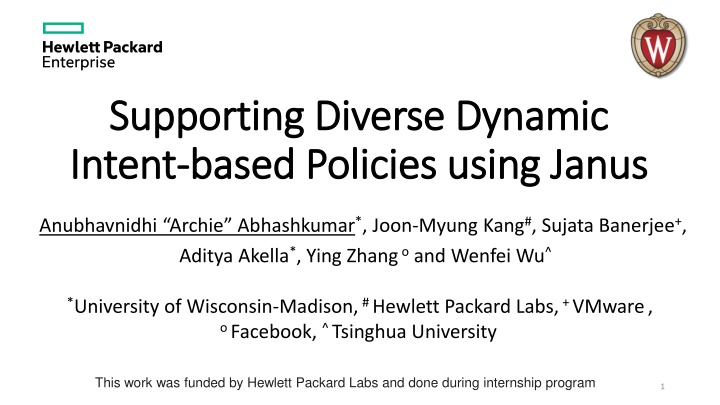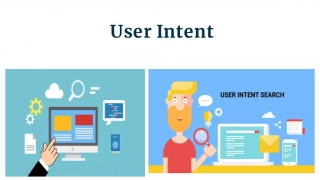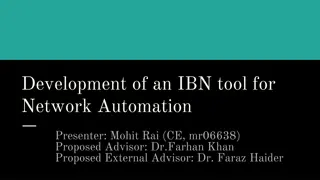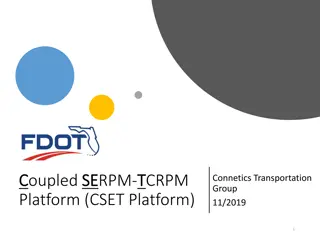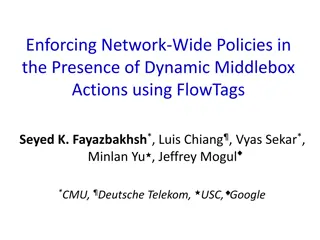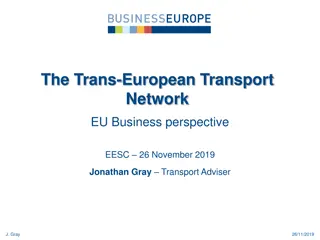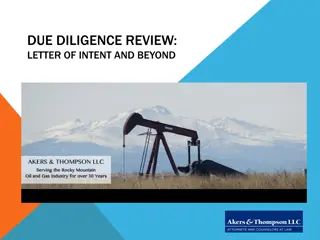Dynamic Intent-Based Policies for Network Management
This work discusses the implementation of dynamic intent-based policies for network management using Janus, focusing on diverse and flexible approaches to policy enforcement in complex network environments. The images showcase various aspects such as reachability, waypoint routing, performance, stateful networks, and temporal constraints in network policy enforcement.
Download Presentation

Please find below an Image/Link to download the presentation.
The content on the website is provided AS IS for your information and personal use only. It may not be sold, licensed, or shared on other websites without obtaining consent from the author.If you encounter any issues during the download, it is possible that the publisher has removed the file from their server.
You are allowed to download the files provided on this website for personal or commercial use, subject to the condition that they are used lawfully. All files are the property of their respective owners.
The content on the website is provided AS IS for your information and personal use only. It may not be sold, licensed, or shared on other websites without obtaining consent from the author.
E N D
Presentation Transcript
Supporting Diverse Dynamic Supporting Diverse Dynamic Intent Intent- -based Policies using Janus based Policies using Janus Anubhavnidhi Archie Abhashkumar*, Joon-Myung Kang#, Sujata Banerjee+, Aditya Akella*, Ying Zhangoand Wenfei Wu^ *University of Wisconsin-Madison, # Hewlett Packard Labs, + VMware, o Facebook, ^ Tsinghua University This work was funded by Hewlett Packard Labs and done during internship program 1
Intent-based policies Describes "what you want" instead of "what to do" 2
Intent-based network policies: Reachability Marketing must access database server and not access web Marketing must access database server and not access web servers servers Reachability Web DB Database Server IDS FW Web Server 3
Intent-based network policies: Waypoint Marketing must access database servers only through a Marketing must access database servers only through a firewall firewall Reachability Waypoint IDS DB Database Server IDS FW Web Server 4
Intent-based network policies: Performance/QoS Marketing must access database servers with minimum Marketing must access database servers with minimum bandwidth of 100 bandwidth of 100 mbps mbps Reachability Waypoint QoS 50 mbps DB 50 mbps Database Server 100 mbps 100 mbps 100 mbps Web Server 100 mbps 5
Intent-based network policies: Stateful Networks Lightweight Intrusion Detection System (L Lightweight Intrusion Detection System (L- -IDS) must forward traffic with more than 2 failed connection to Heavyweight IDS (H more than 2 failed connection to Heavyweight IDS (H- -IDS) IDS) must forward traffic with IDS) Reachability Waypoint QoS Stateful L-IDS DB DB DB Database Server L-IDS H-IDS Web Server 6
Intent-based network policies: Temporal (Time based) Marketing cannot access database servers from 5 pm to 9 Marketing cannot access database servers from 5 pm to 9 am am Reachability Waypoint QoS Stateful Temporal DB Database Server 9 am to 5 pm IDS FW Web Server 7
Intent-based network policies: Temporal (Time based) Marketing cannot access database servers from 5 pm to 9 Marketing cannot access database servers from 5 pm to 9 am am Reachability Waypoint QoS Stateful Temporal DB Database Server IDS 5 pm to 9 am FW Web Server 8
Intent-based network policies: Group based Marketing must access database servers only after going Marketing must access database servers only after going through an IDS with minimum bandwidth of 50 through an IDS with minimum bandwidth of 50 mbps mbps Reachability Waypoint QoS Stateful Temporal Group IDS 50 mbps DB 100 mbps Marketing 1 Database Server IDS 100 mbps 100 mbps 100 mbps FW DB Web Server 100 mbps Marketing 2 9
Existing Works Policies Policies Policies Policies PGA (Sigcomm 15) PGA (Sigcomm 15) PGA (Sigcomm 15) PGA (Sigcomm 15) Merlin Merlin Kinetic (NSDI 15) Kinetic (NSDI 15) Merlin (CoNext 14) (CoNext 14) (CoNext 14) Janus Group-based Group-based Group-based Group-based Reachability Reachability Reachability Reachability Waypoint Waypoint Waypoint Waypoint Bandwidth Bandwidth Bandwidth Bandwidth Stateful Stateful Stateful Stateful Temporal Temporal Temporal Temporal 10
Design Overview Get users input policies as graph Policies Network Topology Get network topology and state info Janus Encodes policies & network as Integer Linear Program (ILP) Best datapath configurations Control Platforms (ex. POX, ONOS, etc.) Install rules host Install solution (paths) as rules in network host 12
Challenge A: Group Atomicity FW min b/w: 50 mbps May not always satisfy all policies Avoid partially configuring policies Web Mktg min b/w: 50 mbps DB IT s3 s2 s1 mktg1 mktg1 70 mbps 100 mbps web1 web1 it1 it1 100 mbps mktg2 mktg2 db1 db1 100 mbps 100 mbps s5 s4 s6 13
Challenge B: Avoid Excessive path changes IDS Choosing this path earlier would avoid an extra path change Path change requires min b/w: 100 mbps Web Mktg min b/w: 100 mbps DB IT FW db1 s1 100 mbps s3 100 mbps s4 mktg1 100 mbps 100 mbps 100 mbps s7 100 mbps 100 mbps it1 web1 100 mbps s5 100 mbps s6 s2 14
Challenge B: Avoid Excessive path changes Choosing this path earlier would avoid an extra path change Path change requires Changing switch rules Transferring NF states Both incur significant overhead db1 s1 100 mbps s3 100 mbps s4 mktg1 100 mbps 100 mbps 100 mbps s7 100 mbps 100 mbps it1 web1 100 mbps s5 100 mbps s6 s2 15
Heuristics used in Janus Configuring policies at group atomicity Configuring stateful and temporal policies Negotiating configuration of more policies 16
Configuring policies at group atomicity Policies Network Topology Encode network topology and policy as constraints Solution recast to path- based Policy satisfied at group granularity ILP => Considers all paths as candidates Exponential with network size Long runtime Janus Objective: Maximize no. of configured group policies Best datapath configurations Path1 s3 s2 s1 mktg1 mktg1 50 mbps 100 mbps host web1 web1 host it1 it1 Path2 Janus => Consider X paths 100 mbps Path3 mktg2 mktg2 db1 db1 17 100 mbps 100 mbps s5 s4 s6
Configuring Stateful Policies Every stateful policy has a default and non-default edge 2 types of constraints: default edge - hard constraints - must be satisfied non-default edge - soft constraints - can be satisfied but not at the expense of other hard constraints Penalize violating soft constraints failed conn < 2 Student Web L-IDS failed connections >=2 H-IDS 18
Time-based joint optimization problem Each time-period t has a separate Linear Program LP(t) For each LP(t) Primary goal : configure all non-temporal policies and temporal policies valid at time t Secondary goal : reduce path changes that happen at other time period (~t) Objective: Maximize (no. of configured policies penalty x no. of path changes) This is a Joint optimization problem Time: 1 to 9 min b/w: 100 mbps Time: 14 to 1 min b/w: 50 mbps Time: 9 to 14 min b/w: 50 mbps Web Mktg Mktg Web Mktg Web IT DB DB IT IT DB min b/w: 100 mbps min b/w: 50 mbps min b/w: 50 mbps 19
Greedy approach for configuring temporal policy At time t(0) Non-temporal policies, Temporal policies valid for time t(0): Hard Constraint Temporal policies valid for other time TP- t(0): Soft Constraint Remaining time periods t(r) = {TP- t(0)} Similar hard and soft constraint Additional objective: Minimize path changes from previous time period t(r-1) 20
Negotiating configuration of more policies FW FW min b/w: 20 mbps min b/w: 50 mbps Web Web Mktg Mktg Janus makes binary decision : policy either gets its full bandwidth requirement (Or) not configured at all Some links not fully utilized Time: 14 to 1 Time: 0 to 24 min b/w: 70 mbps Time: 1 to 14 min b/w: 50 mbps DB IT Bottleneck period: 14 to 1 20 mbps Unused Time: 14 to 1 s3 s2 s1 mktg1 mktg1 70 mbps 100 mbps web1 web1 it1 it1 100 mbps mktg2 mktg2 db1 db1 100 mbps 100 mbps s5 s4 s6 Negotiation: Policies reduce bandwidth requirement at bottleneck Negotiation: Policies reduce bandwidth requirement at bottleneck period and get compensated later period and get compensated later 21
Negotiating configuration of more policies Find top K% policies based on bandwidth usage on bottleneck links Sensitivity analysis to detect set of bottleneck links Find time period tb where K% policies can reduce their bandwidth at time period tb by N% increase their bandwidth at any time period ~tb by N% Notify K% policies of proposed changes 22
Implementation and Evaluation 23
Implementation Details Policies Network Topology Prototyped in Python and Pyretic Pyretic supports static and dynamic function boxes Uses POX to install rules in network Openflow can use queues to implement QoS policies Modified Pyretic and POX to install queue based rules Janus Best datapath configurations Control Platforms (ex. POX, ONOS, etc.) Install rules host host 24
Experiment Setup Use topologies from the Internet Topology Zoo dataset (http://www.topology-zoo.org/) Randomly attach different endpoints and NFs to different nodes Synthetically create our policy dataset Use time and optimality gap as metrics Optimality gap - percentage difference between the number of policies satisfied by the original ILP and Janus. Ran experiments on system with 32 cores, 2.4 GHz Intel Xeon Processor and 128 GB RAM 25
Evaluation: How many candidate paths to consider? Topology Topology Optimality Gap (%) Optimality Gap (%) 10 Paths 10 Paths 5 Paths 5 Paths 2 Paths 2 Paths # of policies = 1000 # of endpoints per policy = 40 # of hosts = 40000 Ans(18) Ans(18) 0.6 0.6 10.3 10.3 23.2 23.2 Agis(25) Agis(25) 0 0 0 0 14.6 14.6 CrlNetServ(33) CrlNetServ(33) 0.9 0.9 10.7 10.7 25.8 25.8 Cwix(36) Cwix(36) 0 0 4 4 19.8 19.8 Garr201008(36) Garr201008(36) 0 0 3.3 3.3 12.4 12.4 Topology Topology Percentage reduction in Time (%) Time (%) Percentage reduction in 10 Paths 10 Paths 5 Paths 5 Paths 2 Paths 2 Paths Ans(18) Ans(18) 77.4 77.4 93.8 93.8 97.3 97.3 Agis(25) Agis(25) 49 49 61 61 88.9 88.9 CrlNetServ(33) CrlNetServ(33) 37.8 37.8 66.8 66.8 87.9 87.9 Cwix(36) Cwix(36) 42 42 58.5 58.5 87.4 87.4 Garr201008(36) Garr201008(36) 97 97 99 99 99 99 26
Evaluation: Penalty for Soft constraints = penalty weight to violate soft constraint = 0.2 satisfies all default and 30 to 70 % non- default policies 27
Evaluation: Configuring temporal policies Spread policies across 5 time periods Set penalty weight for path change = 0.2 Joint optimization algorithm runtime > 20 hours No. of Policies No. of Policies No. of Policies No. of Configured Policies Policies Policies No. of Configured No. of Configured Reduction in Path Path Reduction in Reduction in Path changes(%) changes(%) changes(%) Time(s) Time(s) Time(s) 500 500 500 500 500 500 98.2 98.2 98.2 492 492 492 600 600 600 600 600 600 94.7 94.7 94.7 675 675 675 700 700 700 691 691 691 92.6 92.6 92.6 1438 1438 1438 800 800 800 741 741 741 91.3 91.3 91.3 4157 4157 4157 28
Evaluation: Negotiation to configure more policies Configure 600 policies across 4 time periods Without negotiation => configure 536 policies After K = 60%, increase in number of extra policies configured is not After K = 60%, increase in number of extra policies configured is not When N > 5%, number of negotiable policies decreases due to lack When N > 5%, number of negotiable policies decreases due to lack of extra bandwidth at other time periods of extra bandwidth at other time periods significant significant 29
Extension, Future Work and Conclusion 30
Extension to other QoS metrics Jitter Use multi-level priority queues Queue level assigned based on jitter policy Latency Number of hops as a proxy for latency Need Support for other performance/QoS metrics 31
Future Work: Fast/consistent bulk rule update Fast/consistent bulk rule update Issues: Maintain consistency during rule update Fast rule update to reduce downtime Integrate existing solutions : Dionysus (Sigcomm 14) and McClurg et al s automated update synthesis (PLDI 15) 32
Conclusion Proposed Janus, a system to configure QoS and dynamic intent- based policies at group granularity Developed variety of novel heuristic algorithms which maximize the number of configured policies and minimize the number of path changes Offer near optimal solution in a reasonable amount of time for several network topologies and scenarios 33
Use Policy Graph Abstractions (PGA) to specify Intents Why we chose PGA? Network policies intuitively represented as graphs DB Marketing IDS Compose policies from different policy writers DB Marketing FW Used in real life systems like OpenDaylight DB Marketing 35
Extension to Policy Graphs Add Add QoS QoS and State as edge property and State as edge property 9am 6pm min b/w: low tcp:80 tcp:80 failed conn < 4 L-IDS Marketing Marketing Marketing Web Web Web FW min b/w: high (200 mbps) Marketing failed connections >=4 Web 6pm 5am min b/w: high IDS H-IDS FW Composing policies is straightforward [Details are in paper] 36
Evaluation: ILP VS Janus with 5 candidate paths Each policy has 20 endpoints With bandwidth requirement 10 to 30 mbps 0 Optimality Gap 2x difference in magnitude 37
